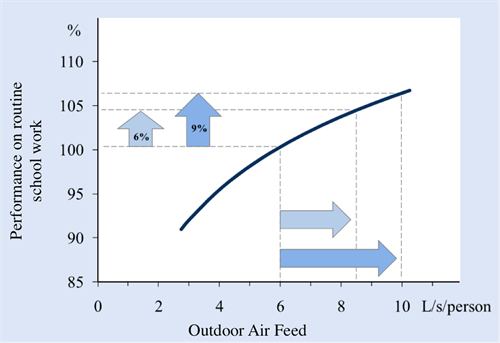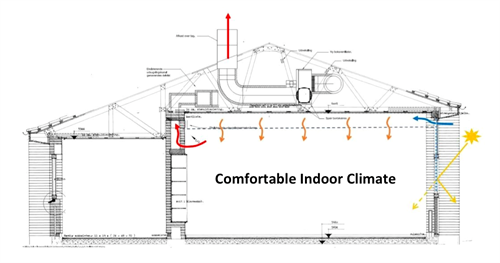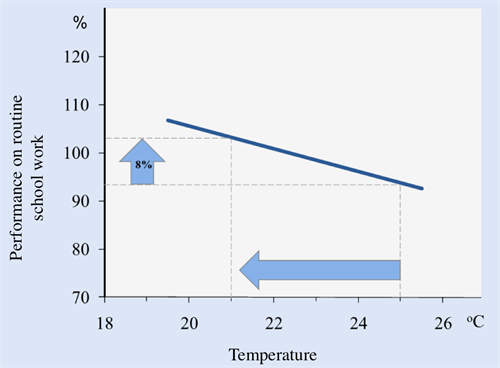Today, we often forget the possibilities for a better indoor climate in the pursuit of energy savings. In the energy renovation of Solbjergskolens façades, the school achieved added value in terms of a better indoor climate - a big win at a small additional expense.
Recent research in Danish schools show that air quality does not meet the requirements more than half the time. This is a problem for the children's learning ability and concentration in schools as well as for our society's future in a broader perspective. In comparison to adults, a poor indoor climate is more critical for children as they are still developing. In fact, children can miss the equivalent of more than one educational school year because of a bad indoor climate.

Fig. 1: Several studies show that children's performance can be improved by a limited increase in air supply. In addition, better air quality can improve children's well-being and reduce sickness absence. [Indoor climate in schools - status and consequences, Geo Clausen, et al., 2011].
Despite major investments in energy optimizations in Danish schools since 2010, measurements show that air quality has not improved significantly and that the indoor climate is lagging behind our neighboring countries [Indoor Climate in Schools, Realdania, 2017].
Improved indoor climate as added value
A holistic approach to the renovation of a school in Solbjerg in Aarhus, Denmark created added benefits by improving the indoor climate. This was done by increasing the airflow using natural ventilation through openings placed in the upper part of the new façade modules. The air is supplied evenly through newly installed Troldtekt ceilings in each classroom. The evenly distributed air supply allows for larger airflows by natural ventilation without draught. The window glass has built-in solar shading, MicroShade. This solution provides an effective reflection of the sun and the risk of overheating is reduced thus resulting in an improved ability to concentrate for children and teachers alike.
The façade modules were pre-fabricated and adapted to the existing building's geometry and use, which ensured easy installation during the renovation. The capacity of the air extraction system is 600 m³/h per class room corresponding to the fresh air requirement of the Building Regulations in 2010 (BR10). The air change rate before the renovation was significantly lower.
Fig. 2: Concept for facade renovation. Air intake happens through openings in the upper part of the façade. The air is distributed above the suspended ceilings and supplied to the room through the permeable ceilings. The evenly distributed air supply allows for draught-free ventilation

Added value for the children
In renovations, focus is often limited exclusively to energy, while the indoor climate and thus indirectly the children's future is often overlooked despite the fact that media attention on indoor climate problems in schools is quite regular.
With a holistic approach, projects can achieve added value in the form of an improved indoor climate - for the benefit of both teachers’ and children's well-being and learning.
In connection with the renovation of the façades of Solbergskolen it was necessary to control the intake of natural ventilation in order to improve the indoor climate and to invest in glazing containing MicroShade. The additional cost of these improvement measures is overshadowed by the effect that the renovation has on the children's learning.
Fig. 3: Several studies show that at higher room temperatures, the children's ability to perform is reduced. The Microshade reduces the solar heat gain and thus the risk of overheating.

In the post-renovation period (from 2010 to 2017) the grade point average improved by 20 percent. In addition, sickness absence was reduced from 5.1 percent to only 2.6 percent, which is significantly lower than the national average.
The Solbjerg case is a good example of the value added by taking the indoor climate into consideration when conducting energy renovations - and why this should be mandatory.